
 |
The Enterprise Mission |
|---|
The "Age of Horus" Dawns
Or
The Time is Now ...
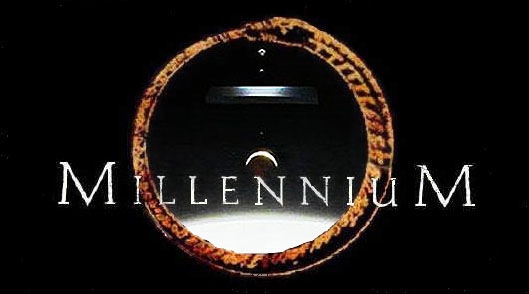
... Because it's Later Than You Think
Part IV
CONTACT INFORMATION:
MICHAEL BARA
lunaranomalies@uswest.net
RICHARD C. HOAGLAND
The Enterprise Mission
P. O. Box 1180
Tijeras, NM 87059
FAX (505) 286-6130
© 2000 THE ENTERPRISE MISSION
In discussing the decision by the Church to ignore Na'amat Allah's 33-year (with repeating "8-leap-year") cycle, Cassidy and Steele have pointed to the ability of that system alone to determine an exact "true Equinox" longitude on Earth. As we have learned, Clavius' system spread the Equinox out over a 53-hour range, but there was nowhere on Earth that could have a true midnight-to-midnight Equinox. Under Allah's system, the Equinox, while neatly confined to a 24-hour period, would necessarily straddle two consecutive calendar dates. For instance, at Greenwich, England, the Equinox would fall from5:08 AM on March 21st to 5:08 AM on March the 22nd.
Assuming, however, the ultimately correct 11-day calendar change, under Allah's system the Equinox would always fall between midnight and midnight, but only within a narrow band of specific longitude. Along this strip of longitude the Equinox would always have occurred on March 21st. Therefore, this specific band of longitude would be the only one on Earth within which the Nicene edict could stay -- for literally thousands of years -- astronomically correct. This would probably have come to be seen as "God's Chosen Meridian," by all Churches that recognized the Nicene council.
That longitude is 77° West.
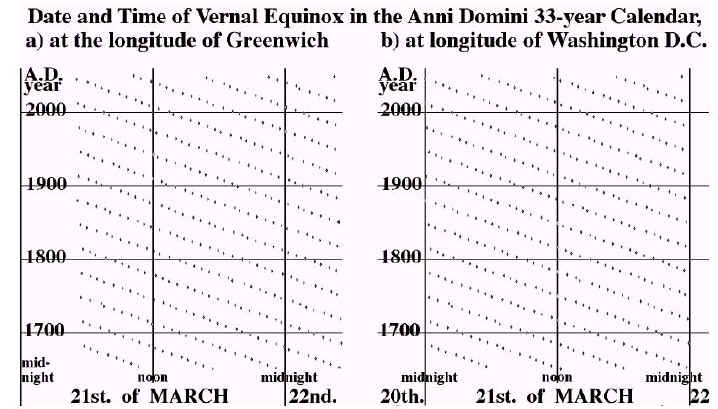
Graphic by Simon Cassidy
Observers will note that this is the longitude, to a high degree of precision, of the capitol city of the United States, Washington D.C. There is even a "meridian hill" in Washington that marks out the precise location of 77° West, placed there by the architect of the city, Pierre Charles L'Enfante. It is also the longitude of the first English settlements in North America. This, we do not think, is a coincidence. We are not alone in this suspicion.
Cassidy and Steele are also convinced that the English came to America not for any of the conventionally accepted reasons, but to claim a piece of " God's longitude." As we shall next see, the reasons are more than merely "Christian," and may have everything to do with chaos we have seen in Florida, and may yet see in the skies above ...
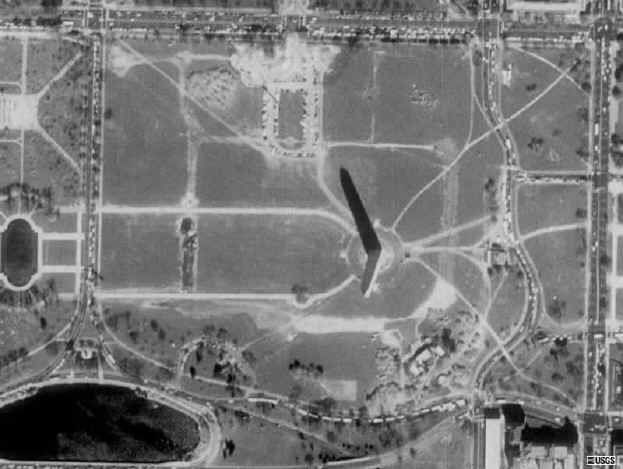
To any Christian believer, this tract of land would truly have been viewed as "sacred." As the only place in the world where the true Equinox could have been observed, the holders of this precious parcel could truly claim to possess "the Promised Land." At the time of Gregory, this strip of longitude in the New World was the exclusive province of the Spanish. This meant that " God's longitude" was under Catholic, not Protestant control. Cassidy and Steele have asserted that the reason for not adopting Allah's 33-year "Life of Christ" calendar cycle was because the Vatican feared tipping off the English as to the symbolic significance of this unique strip of land. They then suggest that when the English finally figured it out (after reviewing the Vatican's 1582 Reform Proposal), Elizabeth I (and her successor King James I), promptly launched a secret campaign to wrest control of this crucial longitude in the New World from those who previously claimed it. In this way, somewhat inexplicable geographical and historical decisions, as to the curious placement of these early English settlements, finally begin to make sense. As Steele puts it:
If you look down that meridian you will find that in the 1580s the settled areas (in the Caribbean, Peru, etc.) were under Spanish, hence Catholic, control. To grab part of God's Longitude and found a New Albion, enabling them to introduce a rival calendar — that Perfect Christian Calendar — and convert the other Christian states to the Protestant side, England mounted various expeditions which historians have since misinterpreted. In 1584-90 the so-called Lost Colony was sent to Roanoke Island, a bizarre place to attempt to start colonization but an excellent site from which to make astronomical observations to fix the longitude and thus decide how far inland New Albion should be. Similarly in 1607 the choice of Jamestown Island seems bizarre from the settlement perspective — why not out on Chesapeake Bay, and away from the attacks of the local Algonquians led by Pocahontas' father Powhatan? — but makes sense from the paramount need to grab a piece of God's Longitude. From the foothold the English managed to gain, Old Virginny grew and later other colonizers came to New England, and New Amsterdam was bought from the Dutch. But later utility/developments do not reflect the original purpose of the English coming to Roanoke Island and Jamestown Island any more than the Eiffel Tower was built to provide a mount for the many radio antennas which now festoon its apex.
Their theory is quite plausible, as far as it goes. But it ignores the obvious: if the Catholic Church knew the significance of the 77° longitude, they would certainly realize that the English knew it too, once they observed the settlement patterns of the first English expeditions. Why not then just go ahead and implement their better 33-year calendar? And why did the English never themselves implement "the perfect Christian Calendar?" What was to be gained in "Christian" (or, more practically, Protestant) terms of keeping up Gregory's ruse?
Nothing. Which is the problem.
So, do we have an alternative explanation ... a compelling reason that the 33-year calendar cycle has continued to be publicly suppressed (and by both sides) for the intervening 400 years?
What do you think?
To understand the motives of both sides, it is educational to examine the key figure in the English decision to seek the holy longitude in the new world, Dr. JohnDee.
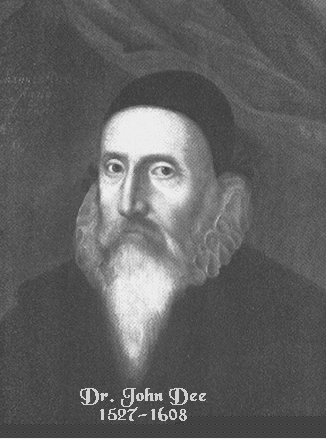
Dee was a scientist, mathematician, and one of the most brilliant men of his age. Among his many accomplishments, Dee could list a series of writings on mathematics which rivaled those of contemporaries like Copernicus. His "Mathematical Preface" to Euclide's Geometry was written in English, rather than the traditional academic language of Latin so that it might be understood by the common people. Considered by historians to be equal in stature with Francis Bacon's 17th Century Advancement In Learning, Dee's "Mathematical Preface" was the first treatise in history that was specifically directed to all individuals who qualified as "Unfained Lovers of Truth," in order to open and expand the world of science for all people.
He was also in many ways the father of the British empire, as he was the one who established the legal claims of colonial territories world wide for Queen Elizabeth. He also applied Euclidian geometry to naval navigation, writing several books on the subject and drawing up charts for navigational use as well as designing instruments for the ships at sea to apply the principals he had developed. He eventually amassed a vast library of over 4,000 books on subjects ranging from ancient religions to the modern sciences.
Of course, like Caesar before him, he was also a mystic, a deist (a man of god who subscribed to no particular religion) and the Royal Astrologer to Queen Elizabeth I. Dee had ingratiated himself to Elizabeth during the reign of her Catholic sister, Queen Mary, by providing her with horoscopes for both Elizabeth and her sister. Mary had him imprisoned for sorcery, but upon her death Elizabeth brought him in as an advisor to her privy council. Dee used his talents as an astrologer to select the date of the Queen's coronation, and he was also a close friend of Francis Walsingham, head of Elizabeth's secret police. Walsingham used Dee frequently on overseas missions, where he acted as an agent for England. In this capacity, he always signed his correspondence with the Queen with the mark "007," and was used loosely as the model for Ian Fleming's super spy James Bond. Dee was also well acquainted with William Shakespeare, who apparently based his characters "King Lear" and "Prospero" (of "The Tempest") on Dee's highly complex life.
That last portrayal, of a man influenced and ultimately controlled by his fascination with magic, is perhaps most crucial; for while Dee was a God-fearing man and one the most accomplished scientists of his day, it was his forays into "magical pursuits" which ultimately defined him. In fact, one of Dee's biographers described him as "Elizabethan England's great magus."
That particular depiction is important, because of the crucial role of the "Magi" (from which the term "Magus" comes) in the historical events we have already described: namely, the birth and death ... and birth again of Christ, around which our Western Calendar for the last 2000 years (supposedly) revolved. According to Adrian Gilbert, author of " Signs in the Sky," the Magi were a secret priesthood educated in the Egyptian "Orion mysteries," who managed to find their way to the birthplace of Christ. They are the "Three Kings of Orient" (Orion) spoken of in the Gospel of Matthew, and Gilbert argues that they specifically saw Jesus as a "Horus King" type-figure. That Dee may have been linked with such a group is not particularly far fetched, as he had some noble blood in his family line and the Magi were a bloodline priesthood. If indeed the Magi were "King's from Orion," and Dee considered himself one of them, then his loyalties would necessarily be to that much older order, rather then the more modern Christian churches. This conclusion becomes even more obvious when we look at the actual magic rituals in which Dee thoroughly engaged.
Dee was a practitioner of "Hermetic gnosticism," a school of thought based on the ancient pre-Christian teachings of the Greek god Hermes. Hermes was in fact a mere copy of the much earlier Egyptian god of knowledge and language, Thoth. In this sense, all "Hermetic gnosticism" can be viewed as a worship of the teachings of Thoth. According to the Egyptian mythos, Thoth was one of the gods who came down to Earth, along with Isis and Osiris, to bring the fruits of knowledge, civilization and the sciences to the Egyptian people. This triumvirate of gods is the key to what became the vast Egyptian civilization, and Thoth is in fact thought to be the god who commissioned the great pyramids at Giza.
Dee was a learned man, and in his spiritual journeys he had discovered quite a bit about the ancient mystery schools of Egypt. In 1581, using his knowledge of these ancient practices, he began a series of attempts to communicate with "higher beings." His channel in this capacity was one Sir Edward Kelly, something of a self-educated rogue but a man well known to the English courts.
The focus of their efforts was to obtain the knowledge of the Book of Enoch, a supposed "lost book of the Bible" that contained the truth about man's existence, the afterlife and his future on Earth. Enoch was a fairly obscure figure in the now-traditional Bible, being seventh (tetrahedral spin symmetries anyone?) in line from Adam. Enoch, however, was unique in one respect: he was considered immortal, because God had taken him to Heaven without benefit of death after 365 years on Earth (an obviously important symbolic "connection" of Enoch with the calendar year ...). As Knight and Lomas have shown, Enoch is also the central figure around which a great deal of Masonic legend is centered, as he is said to have constructed the two pillars of Masonic lore to preserve the antediluvian high knowledge of Atlantis inside them.
Dee and Kelly were evidently successful in their attempts, as they eventually contacted an "angel" named Uriel. Uriel first provided them with complex alphabet of angelic language, and then proceeded to dictate the entire Book of Enoch to Kelly in this language. Dee, in turn, dutifully recorded all that was passed to the both of them by Uriel, and the various spells and incantations used and dictated in this process became a school of magic known as "Enochian magic." Strangely, portions of the apocryphal "Book of Enoch" were brought to Europe from Ethiopia in the 1700's, and were also found among the Dead Sea scrolls in 1947. Dee's version appears to be pretty much the same as those far later discoveries, and advocates of the Hermetic tradition have pointed to this as proof of Dee's success in contacting a higher spiritual being. However, given Dee's vast library of rare books and (as we have and will show) his affinity for the knowledge of ancient Egypt, it is also plausible that he got his information from one of those secret textural sources.
All of this would seem on the surface to be wholly irrelevant to the questions at hand, much less to the issues of "Faces on Mars" or on-going "ritual NASA cover-ups." However, this is not the case. Dee had an immense effect on later occultists, most notably Aliester Crowley. You may be surprised to find that both Crowley and Dee in turn had very influential effect on the founders of NASA's Jet Propulsion Laboratory. That story, as extraordinary as it is and as important as it will ultimately become to understanding some currently inexplicable "ritual space events," is best discussed at another time. Suffice it to say that, unknown to almost all but a handful of academics, Dee's mystic pursuits reached far beyond Elizabethan England ... to cast a major shadow well into our Time.
The relevance to the entire issue of deliberate "calendar manipulation" is best understood when we look at Dee's involvement in the English response to the Gregorian Reform. After receiving a copy of the Papal Bull in diplomatic correspondence, Walsingham assigned Dee the task of evaluating England's course of action in the matter. Dee threw himself into the work, even setting aside his channeling with Kelly to fully devote himself to the task at hand. Dee worked under the utmost secrecy, an action which is interpreted by Cassidy as a need to keep the Spanish (and hence the Catholics) from learning that England was investigating the calendrical longitude.
Dee eventually finished his work "A playne Discourse and humble Advisefor our Gratious Queen Elizabeth, her most Excellent Majestie to peruse and consider, as concerning the needful Reformation of the Vulgar Kalendar for the civile years and daies accompting, or verifyeng, according to the time truely spent" on February 26th, 1582, and delivered it to Lord Treasurer Burghley to present to the Queen. In it, Dee called for an 11-day correction, as opposed to the Gregorian 10-day correction for 1582. But a note attached to the work allowed for a 10-day correction in 1583. In a complicated exercise explained by Cassidy, he asserts that Dee was actually trying to implement the 33-year"Anni-Domini" (Allah's) calendar by only seeming to "accept" the Papal Decree. But Dee's 10-day correction would only work if 1584 was declared subsequently not to be a leap year. This, however, was not done, and England stayed on its own calendar until 1752, when they finally acceded to the Gregorian Reform that most of the rest of the world had long been using --,but with an 11-day correction (instead of the "Gregorian" 10).In doing so, they actually set (by their own clock) the date of the Vernal Equinox on March 21st ... but only on "God's Longitude."
The issue of whether Dee was, by his "footnote," actually agreeing with the Gregorian correction is a controversial one among most scholars. The traditional view is that his note was meant to give the Queen an "out," in order to facilitate continued diplomatic communication and commerce with the Catholic world. Not only is this highly unlikely, given his (and the Queen's) documented distaste for Papal authority, but Cassidy points to a verse in Dee's own paper which clearly indicates that he was actually a clandestine advocate of the (remember, highly secret to both sides) 33-yearAnni-Domini Calendar.
ELIZABETH our Empress bright,
Who in the yere of eighty three,
Thus made the truth to come to light,
And civile yere with heaven agree.
But eighty foure, the Pattern is
Of Christ's birth yere: and so for ay
Eche Bissext shall fall little mys,
To shew the sun of Christ birth day.
Three hundred yeres, shall not remove
The sun, one day, from this new match:
Nature, no more shall us reprove
Her golden tyme, so yll to watch.
Cassidy notes the following:
The third verse is usually held to predict that the accuracy of the new calendar will match the sun's behaviour (every Christmas day?) to an accuracy of one day in three hundred years. This is not much of a claim to accuracy since it implies a possible error of up to 0.0033 days between the real solar year (based on Christmas or New Year?) and the proposed Elizabethan reform's average year ... If Dee really meant to follow the Gregorian year-length and leap-year rule, then he would have known that the accuracy (for any point in the tropical zodiac) was much better than this apparent 0.0033 days/year claim ...
What is happening here is that Dee is embedding a code -- a deliberate and obvious error in his calculations -- which just happens to come out to a "decimal harmonic" of "33!" He was trying to signal to anyone "in the game" the significance of the cycle of "33."
The final verse is further viewed by Cassidy as claiming that for the next 300 years (from 1582) the Vernal Equinox will always fall on the same calendar day at some unspecified longitude. This in a nutshell is exactly the power and perfection of the 33 year Anni-Domini calendar cycle! And, it turns out to be -- in Cassidy's words -- "uncannily accurate." For if Dee's proposal had been implemented as he proposed, then the Vernal Equinox would have fallen on the March 21st, the exact Nicene date, at the 77° West longitude from 1580 to 1880.
What this all means is that, while Dee's paper created an impression that he could live with the Gregorian ten-day reform, he actually (and privately) fully understood the incredible significance of the "Holy Longitude" and the secret 33-yearAnni-Domini Calendar cycle. Further, he let it be known that England could wait upwards of 300 years to actually implement the proper reform, and still be within the bounds of the AD calendar. That this was clearly understood by Queen Elizabeth was confirmed when she assured him, in an April, 1583 letter, "Quod defertur non aufertur" (What is deferred, SHALL NOT BE ABORTED!).
Ultimately, the proof of this is not to be found in endless scholarly debates about the meaning of poetic verses, but rather in what specific actions Dee, Sir Walter Ralegh and Queen Elizabeth herself actually undertook ... to implement The Plan.
One needs only look at the subsequent actions of Dee and his associates to quickly determine that Dee had full knowledge of the "AD" calendar and its implicit scared longitude. Dee was heavily involved in a secret society known as the "School of Night," about which virtually nothing is known. Its members certainly did include Dee, Ralegh, Sir Frances Bacon, and a rather mysterious figure, Lord Fernando Strange, Earl of Derby. They met usually at Strange's estate and were viewed with suspicion by the religious leaders of the day because of their access to Queen Elizabeth.
It doesn't take too much to figure out what went on at these meetings, or what the subject of the discussions must have turned to often ... Bacon even wrote a "novel," published only posthumously in 1626, titled provocatively "The New Atlantis." It reads like a virtual roadmap of what these collective mystics had discerned from their studies of the ancient mystery schools of Egypt. The thrust of the story is of a shipwrecked crew landing on "a mysterious shore" in the New World, where they are greeted and ministered to by "a kind, wise old man" and his servants. He is simply the ambassador to what is revealed to be a substantial (and substantially secret) society in the New World. During the course of their stay, many secrets are revealed to them. There are barely veiled references to the "Society of Saloman's House" (an obvious allusion to the Masons -- who in their own lore are the ancient designers of Solomon's Temple), and a flat Egyptian-type (Horus) statement that this society is "the very eye of this kingdom." The book also contains references to "the coming Apocalypse," and states matter-of-factly that America is the land of Atlantis. It goes on to tell the tale of a vast and technologically advanced civilization overtaken by a catastrophic ancient inundation ...
That this is simply a thinly-veiled master plan for what was to become the "United States of America" could not be more clear. Bacon saw an egalitarian utopia springing forth in the New World, based on Hermetic "natural laws" and overseen by a quiet, benevolent secret society. That Dee, Bacon, Ralegh and their contemporaries sought to achieve this utopian state in the North American British colonies themselves is confirmed by their later actions, in which they actually sowed the seeds of the very secret society that they hoped would guide the people of the "New Atlantis." But in order to accomplish this, they must first obtain a foothold there.
When Dee decoded the Anni-Domini calendar, it must have confirmed to the School of Night that which they already suspected: that America was the special place that the antiquarian legends spoke of. What is certain is that immediately after Dee's calendar work was published, he and Ralegh began to do what was necessary for England (and by extension, their secret society) to establish a beachhead in America. By April 1585, after nearly three years of preparation, the first serious English expedition to colonize America was launched under the guidance of John White and Thomas Harriot. Harriot, a student of Dee's and close friend of Ralegh, was already well aware of the significance of the 77° longitude and the 33-year calendar cycle. Cassidy has discovered in Harriot's notes a number of references to the AD calendar system.
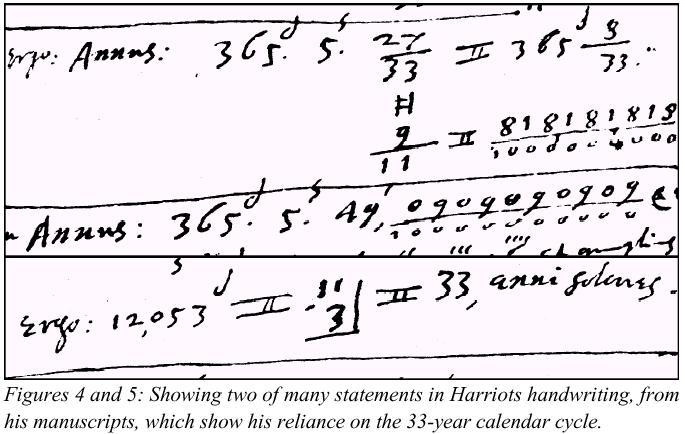
Simon Cassidy
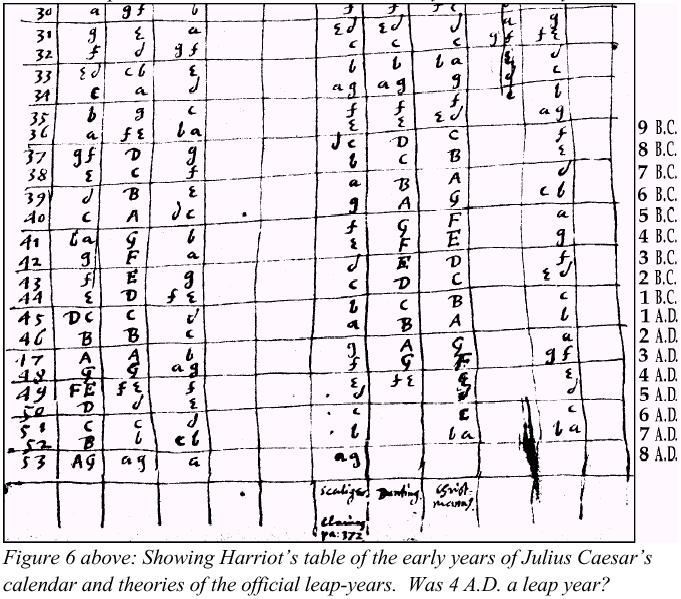
Simon Cassidy
Lest you have any doubts that the location of the new 33-year cycle "prime meridian" was of the utmost concern to these first English settlers, you need only look at where they landed to allay your doubts. From their landing spot at Roanoke Island, Virginia, Harriot and White were in a perfect position to survey the land and the stars (remember, they didn't know it was exactly 77° W when they got there, only that they were close) and according to Cassidy, the proper longitude was marked out on the map that White brought back.
But things did not go smoothly. The first colony failed, as did a second in 1587. By 1588, England had other worries as the Spanish Armada set sail to invade her. Dee is famously credited with casting a "hex" on the Armada and conjuring the bad weather which contributed more to the Armada's defeat than anything the English navy did. Such was the extent of his reputation at the time.
As England lost interest temporarily in the New Atlantis, Dee and the School of Night set about creating a new movement which they intended to be the guiding star of their new World. The Rosicrucians, or "Order of the Rose Cross," are a quasi-Masonic group and had their roots in these early discussions (at least one of which was in Luneburg, Germany in 1586 when Dee was abroad). The order openly grounds itself in the ancient Egyptian mysteries of Isis and Osiris (Sirius and Orion) and it exerted a great influence throughout Europe's ruling elite from the early 1600's on.
But all their plans in the end were foiled. Elizabeth died in 1603 and was replaced on the throne by King James I, of Scotland. James was the first overtly Scottish Rite Masonic Royal, and he quickly imprisoned Dee, Ralegh and Bacon. The Masons obviously saw Dee and the School of Night as rivals in the quest to dominate the New Atlantis, and they were out of favor. Yet James and the Masons themselves must have equally understood the unique significance of the 33-year calendar cycle, because they promptly launched the Jamestown colony, located dead on the 77° W. longitude.
Curiously, Dee and Kelly had both left the British Isles shortly after his presentation of his calendar treatise to Elizabeth to travel in eastern Europe. There they circulated among the royal houses and curried favor with various emperors and kings. Kelly was quite successful in these ventures, Dee less so. Dee had left England in late 1583, to travel through Poland and Bohemia (territory which would ultimately become Germany) at the invitation of Polish Count Lasky. Lasky had rather mysteriously just "shown up" in England inquiring about Dee and Kelly's channeling and other occult activities. Kelly laid claim to success with alchemy (he was actually Knighted by the Holy Roman Emperor Rudolph, ostensibly for his "alchemical" contributions to the Court).
What they seemed to be doing was spreading the knowledge of something among these high houses. We have found that they were very successful in doing so.
Shortly after Dee had returned to England in 1589, a young law student named Johann Bayer (1572-1625) made a contribution to astronomy that almost certainly sprang from this "secret knowledge" that Dee had apparently been spreading "on the Continent." Bayer was a Bavarian "amateur" astronomer, who first named stars by assigning them to constellations and giving then Greek letters (alpha, beta, gamma, delta, etc.), in order of decreasing brightness. His seminal work, the "Uranometria" (published in 1603), not only set this new standard for stellar designation but also created several entirely new constellations ... one of which will ultimately have a major role in unraveling the mystery we have before us.
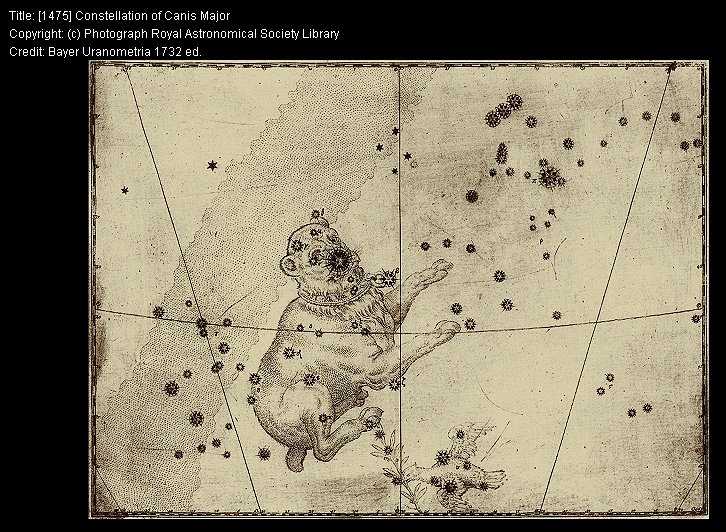
What Bayer did was to literally "carve out" a new constellation from the stars of Canis Major. Canis Major of course contains the key celestial player in the Millennium madness we are documenting -- Sirius. Bayer's new constellation is also located precisely on the meridian with Orion, a relationship which we took to be a "marker" of some kind for future events. He named this new constellation "Columba," apparently after "the dove that is sent out from Noah's Ark to search for dry land after the deluge." What we next needed to do was figure out the history and mythology of this new constellation, and any connection to the New Atlantis Dee and Bacon had been seeking.
According to Allen ("Star Names: Their Lore and Meaning"):
"[Columba] was made up from the southwestern outliers of Canis Major, near to the Ship [Argo] -- Noah's Ark -- and so it was regarded as the attendant Dove."
And from Genesis:
At the end of forty days, after the flood, Noah opened the window of the ark that he had made and sent out the raven to see if it could find dry land; and it went to and fro until the waters were dried up from the earth. Then he sent out the dove from him, to see if the waters had subsided from the face of the ground; but the dove found no place to set its foot, and it returned to him to the ark, for the waters were still on the face of the whole earth. So he put out his hand and took it and brought it into the ark with him. He waited another seven days and again he sent out the dove from the ark; and the dove came back to him in the evening, and there in its beak was a freshly plucked olive leaf; so Noah knew that the waters had subsided from the earth. Then he waited another seven days, and sent out the dove; and it did not return to him any more. (Genesis 8:6-12)
So, why did the authors of Genesis depict a dove in this key role? Because (see Peter Tompkins, and/or Temple) of the geodetic role of doves in "primitive" geographical surveying. So, "doves" equal a priestly code for "earth measurement." And "doves" in the Noah story indicate a need to determine exact lat/long ...again, after a major, watery catastrophe ...
Robert Temple, author of the aforementioned "Sirius Mystery", has exhaustively explained the deeper connection between the Argo (the Ark) and Sirius ... Most interesting is his discussion of the deep (hidden?) relationship between the true nature of the companion to Sirius, Sirius B -- the amazing white dwarf -- and a little known visible star in the same constellation of Canis Major, called by the Arabs, "Al Wazn" -- "Weight" -- so-called (according to a leading Arabic astronomy expert) because "...the star seems to rise with difficulty from the horizon." The Arabic expert, Ideler, called this "an astonishing star name."
Temple goes on to equate this nomenclature, applied to a visible member of Canis Major, with the ancient, degenerate, "hidden knowledge" regarding the actual existence of Sirius B -- the super-dense (but invisible to the naked eye) white dwarf that orbits in the Sirius system. What Temple did not know (or did not report, because he considered it irrelevant for his discussion) was that when Bayer "stole" some of Canis Major's stars to compose the new constellation, "Columba," in 1603 -- one key star of the new constellation was this same "Al Wazn" ... "Weight!" The same star that Temple, just under 400 years later, identifies with a "secret," degenerated knowledge of the Sirian system itself ...
So, there is an undeniable connection (through this star) between the "Sirian Complex" of the Dogon myth and mythos of Canis Major ... and the "new" constellation of Columba, "the Dove."
The other strong connection to Temple's Sirius Mythos comes with Columba's association with "Argo" -- the Southern Constellation representing (loosely) "Noah's Ark" -- and its classic use as an escape from a great planetary flood/disaster.
Temple refers to the other variants of this same Hebrew story then circulating in the Middle East, including "The Egyptian story [according to Allen, that] said that it was the ark that bore Isis and Osiris over the Deluge ..." (!!) Now -- if you refer to the major MIT science historian, the late Livo Stechini (in a significant appendix to Tompkins: "Secrets of the Great Pyramid"), you find that Stechini makes an excellent case that the "doves" of the Noah story are actually a classic Egyptian reference to "a standard Egyptian glyph for the stretching of meridians and parallels." (!)
So ... it's clear that the "secret" creation of a visible new constellation called "the Dove" (Columba) in 1603, out of some Canis Major stars, linked with Argo and the entire Sirian Complex, was not accidental. It was, instead, secretly emblematic at that precise time of the transposition of the terrestrial Egyptian "meridians and parallels" into the sky ..!!!
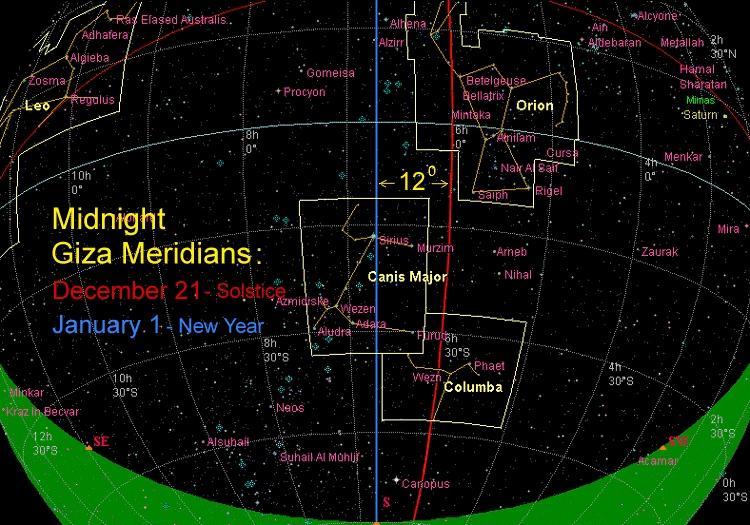
Now, why do you suppose -- just after the BIG Calendar Change at the end of the 16th Century -- someone would have wanted a visible (Egyptian) marker in the sky to denote "celestial meridians and parallels?" Why indeed ... except, in part, to visibly mark in the sky (to those "in the know") the orientation of the critical "plane of the Earth's axis" at the end of the Twentieth Century ... when Sirius would cross the Meridian at Midnight ... in "2000?!"
Now ... things get even more interesting.
As Knight and Lomas have shown in "Uriel's Machine" there was a Sixth Century monk who took the Church from Ireland to Scotland. He also was heavily involved with the importation of a "sacred stone" imported from the holy land (read: ancient Egypt) used in all subsequent Scottish (and later English) Coronations. Oh, his name ..?
"Columba!"
Why was he named "Columba?" And why did the Founding Fathers (mostly Masons -- from "Columba's" new home, from Scotland!!) centuries later call the New Republic they created in the New World "Columbia?" The classical story is, of course, that it all had to do with "Christopher Columbus" -- the "discoverer" of America and the New World; actually, as we have seen, Columbus was only rediscovering the "lost Atlantis" that most learned men of the day already knew was out there. In part, this prior knowledge was reinforced by at least one of the major "best selling manuscripts" of Columbus' time (even Queen Isabella was said to own a copy!): the remarkable story of another Irish monk -- "St. Brendan, the Navigator," a contemporary of "Columba" -- who also (curiously ...) made a pilgrimage to Scotland.
According to Brendan's own telling of the tale, a thousand years before 1492 (!), Brendan and fourteen other monks purportedly sailed west in a fragile skin-clad boat, to seek this fabled "Promised Land." Most of the voyagers, including Brendan himself (his manuscript continues), successfully returned to Ireland after seven years -- with amazing tales of everything, from "whales" to "icebergs," seen along the way.
So, was this a real, 6th Century "Irish Expedition" to the New World, or ... merely a clever means of passing down through the centuries "secret" Gaelic knowledge of this crucial "Promised World?" Even more intriguing: was St. Brendan's name somehow accidentally substituted in this "code" for the far more appropriate (etymologically and geodetically speaking) "Columba," in the centuries-long recopying and retelling of the tale ..? Is this one of the reasons why the Masonic (Scottish) founders of the Republic ultimately called America "Columbia" ..?
We'll probably never know.
What we do know is that, potentially confirming this speculation, is a little known story that Columbus actually with him took one Irish crewman. A true detail -- regarding his desire to have a serious student of "St. Brendan's voyage" on his own extraordinary journey -- or, just another "layer" of the deep symbolic "messages" we have discovered surrounding all of these contemporary speculations regarding the location and meaning of "the New World" ... St. Brendan's "Promised Land?"
In light of these abundant symbols, however, we also think it highly likely at this point that Columbus himself was something of a carefully-crafted "fabrication" -- his own, now legendary name being increasingly doubtful as to its true origin. The literary choice of a "Columbus" (Columba?) as leader of this later 15th Century expedition to the New World would have been supremely appropriate -- as another secret "code" -- carefully meant to memorialize to "the chosen few" this ancient geodetic knowledge of the New World ... and its crucial coming role in "the next Flood."
America: the ultimate "Columba" marker to the celestial ticking clock that only can be understood from this unique New World ... when time runs out -- again.
The sudden astronomical appearance of the "dove" of Columba in sky charts, circa 1603 (remember Dee's preoccupation with navigation; sailing to and establishing colonies in the New World; the "secret" 33-year Calendar; finding (measuring!) "God's Longitude," etc, in this time frame?) indicates the need to determine the exact lat/long of "God's Longitude" in the New World, to accurately PREDICT the NEXT catastrophe ... ergo, the "hidden multi-leveled symbology" of "the Dove." And that is exactly how Columba can be used today ... as the "clock" just south of Orion, to indicate (together with Sirius) exactly how much time we have left ... and measured from WHERE (the United States)... until "Noah" happens again ...
What this all implies is that the members of these various and sundry secret orders had come to believe that there would be another Flood. So much so, that they set up "coded markers" -- both through a series of "staged events" occurring on the ground, as well as clandestine signposts in the sky -- to prepare their descendants with appropriate warnings ... and the Time. They then set about warring over the sacred land (America) that they all believed would play a key role in this coming eschatology. However, it now seems that at least one of these groups, contrary to the prevailing "wisdom," considered the possibility that the whole disaster might well be totally averted!
And even more, this "rogue society" must have understood the danger to their plans if the truth ever came out about the significance of the 33-year cycle calendar. Because, of course, the 33-year calendar is based not on "the life of Christ" at all; it is based, instead, on a major secret held close by the Masonic order itself, and on the curious geometry of some very old things in another old "Atlantis" ... literally on another world ... at a place called Cydonia.
| Click here for part 3 |
The Enterprise Mission
P. O. Box 1180
Tijeras, NM 87059
FAX (505) 286-6130